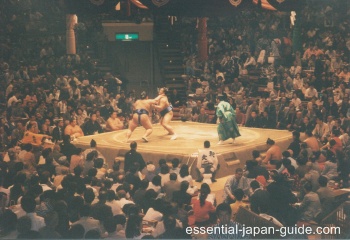Japan Sumo Wrestling

In Japan, sumo wrestling is the country’s national sport, with a rich history dating back centuries, and is a unique and exciting attraction you won’t want to miss during your visit to Japan.
![]()
Introduction to Japan Sumo Wrestling
 Basic Overview of Sumo
Basic Overview of Sumo
Sumo is a form of wrestling in which two ample-sized wrestlers, called rikishi, dressed only in a thick, doughnut-shaped belt called a mawashi, face off inside an elevated dirt ring, called a dohyo, and attempt to either drive their opponent out of the ring or cause him to touch the ground inside the ring with a part of the body other than the feet.
 Origin of Sumo
Origin of Sumo
The earliest form of Japan sumo wrestling originated as part of in Shinto religion, and many Shinto rituals remain intact to this day. Sumo wrestling as a professional sport dates back to Japan’s Edo Period (1603 – 1868).
 Sumo Rules and Rituals
Sumo Rules and Rituals
At first glance, Japan sumo wrestling appears on the surface to be quite simplistic and straightforward, but like so many things in Japanese culture, the sport actually consists of multiple levels of depth and complexity.
Victory in sumo is achieved by either forcing an opponent out of the ring, or causing him to touch a part of the body other than the feet to the floor inside the ring.
Most sumo matches last only a few brief seconds, but the action is fast and furious. Though the majority of matches are won simply by pushing the opponent out of the ring, wrestlers actually draw on a vocabulary of several dozen techniques (kimarite).
Part of the intrigue of sumo is the series of rituals that precede the actual bouts. Rooted in Shinto, wrestlers go through a series of purifying rituals and animations, including a clapping and stamping out of evil spirits from the ring.
Wrestlers will then stare one another down several times before actually engaging in a face-off, called tachi-ai. This slow buildup of tension and anticipation is part of the allure and excitement of sumo.
![]()
Japan Sumo Wrestlers, Ranks and Divisions
 Daily Life of Sumo Wrestlers
Daily Life of Sumo Wrestlers
Sumo wrestlers belong to special dojos, called heya, where they live and train under the tutelage of a retired wrestler. Daily life inside the heya is governed by a strict system of rules and hierarchy. Young aspiring wrestlers are required to practice early in the morning, share in the cooking and cleaning duties, and serve as attendants to the more experienced wrestlers.
Chankonabe is the staple food of Sumo Wrestlers. Read more about chankonabe!
 Sumo Divisions and Ranks
Sumo Divisions and Ranks
Professional sumo in Japan consists of six divisions, beginning at the bottom with Jonokuchi, followed by Jonidan, Sandanme, Makushita, Juryo, and Makuuchi, the highest division.
Most wrestlers begin their careers at the bottom and work their way to the top of the ranks. However, wrestlers with proven amateur records are sometimes permitted to start their careers midway through the ranks.
Wrestlers in the top Makuuchi division are further ranked according to their performance. Lowest ranking Makuuchi wrestlers are called maegashira, followed by komusubi, sekiwake, ozeki, and at the very top, yokozuna.
 Influx of Foreign Wrestlers to Japan Sumo Wrestling
Influx of Foreign Wrestlers to Japan Sumo Wrestling
Following the retirement of Mongolian Sumo Grand Chamption Asashoryu in February 2010, there is currently only one active yokozuna: Hakuho, also of Mongolia. Among the five active ozeki, one, Harumafuji, is also Mongolian, while another, Kotooshu, hails from Bulgaria. Baruto, the newest ozeki who was promoted to the rank in March 2010, is from Estonia.
There are several other wrestlers of Mongolian and and Eastern European origin in the Makuuchi division, evidence of an influx of foreign talent to the sport which began in the 1980s with a group of Hawaiian wrestlers, two of whom, Akebono and Musashimaru, ultimately reached the rank of Yokozuna.
![]()
Japan Sumo Tournaments
There are six official Grand Sumo Tournaments (honbasho) are held every year, each lasting 15 days, beginning and culminating on Sunday. The tournaments are held in January, May, and September at the Kokugikan in Ryogoku, Tokyo, in March in Osaka, in July in Nagoya, and in November in Fukuoka.
![]()
Exerienceing A Sumo Tournament
Don’t miss the opportunity to see a traditional Sumo tournament when you’re in Tokyo. You’ll take the subway with fellow Sumo fans to the Kokugikan (Sumo Amphitheater) and enjoy a traditional Sumo wrestling tournament. You’ll also visit the fascinating Sumo Museum to see Sumo-related objects from the Edo period to the present.
On the day of a tournament, the action begins bright and early in the morning starting with the lower-rank matches. Most fans don’t start filling into the venue until afternoon, when the Makuuchi action begins and the top wrestlers take to the dohyo.
When attending a day of sumo during a match held in Tokyo, you can easily make a fun full day of it. Arrive at the Kokugikan early in the morning to purchase your tickets and also watch as the huge wrestlers arrive and make their way into the arena dressed in traditional Japanese clothing.
Then head to a nearby restaurant to eat chankonabe, a special hearty stew full of meat, fish, and veggies that is the staple food that sumo wrestlers eat to pack on the pounds. Many chankonabe restaurants are owned and operated by former sumo wrestlers.
You can also check out the Edo-Tokyo Museum, which is located right next to the Kokugikan. This is an incredible museum packed with amazing artifacts that detail the history of Tokyo.
Finally, make your way into the Kokugikan and enjoy the sumo action. Makuuchi matches begin around 3:00.
![]()
Check out the Nihon Sumo Kyokai Official Grand Sumo Home Pagefor tournament dates, access to venues, ticket info, and bios of all of the wrestlers.
![]()
